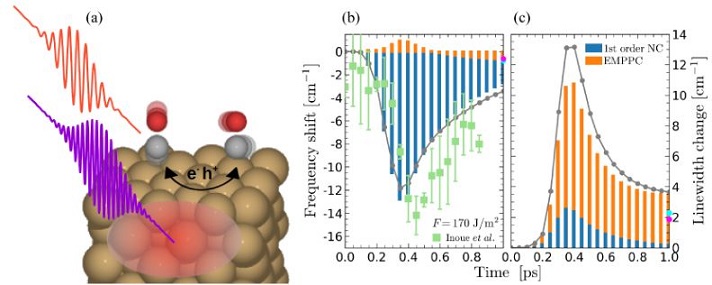This website uses cookies to ensure a better user experience.
To get more information, please read our Cookie Statement.
Ultrafast transient dynamics of adsorbates on surfaces deciphered: the case of CO on Cu(100)
Our colleague Dino Novko and his collaborators from Spain and Germany have published a paper in prestigious journal Physical Review Letters. Combining many-body perturbation theory and an effective temperature model, they have disentangled the electron- and vibration-driven interaction channels in ultrafast CO motion on metal surfaces.
Ultrafast Transient Dynamics of Adsorbates on Surfaces Deciphered: The Case of CO on Cu(100)
Dino Novko, Jean Christophe Tremblay, Maite Alducin, and Joseba Iñaki Juaristi, Physical Review Letters 122, 016806 (2019).
DOI: 10.1103/PhysRevLett.122.016806
One of the most exciting yet challenging goals in surface chemistry is to control surface reactions in both time and space domains. To achieve this goal, numerous pump-probe spectroscopy experiments have been performed to study elementary motions and reactions of adsorbates on metal surfaces, including vibrational motion, diffusion, and molecular desorption. However, the precise microscopic mechanisms causing the transient spectral changes are still not fully understood. The present work took an important step towards the goal by developing a quantitative theoretical framework that enables us to disentangle the contributions of electron- and vibration-driven interactions in the ultrafast vibrational motion of diatomic molecules on metal surfaces under nonthermal conditions. The novel combination of many-body perturbation theory and an ab initio-based effective temperature model unveiled the microscopic mechanisms behind the experimentally observed transient changes of the CO internal stretch mode on Cu(100) induced by femtosecond laser pulses. Such theoretical approach reinforces and complements some of the current beliefs in surface science, and can also deliver novel interpretations to our common understanding. The simulation has shown that the dephasing process precedes the energy exchange between the internal stretch mode and thermally excited molecular low-energy modes. Furthermore, the study resolved the different coupling mechanisms behind the transient frequency and linewidth changes of the internal stretch mode measured in time-resolved sum-frequency spectroscopy. The deep insights delivered by the new theoretical approach will help us understand other ultrafast vibrational motions on metal surfaces, and also motivate new research into the control of surface reactions at the atomic level.

Figure 1: (a) Schematic image of the coupling mechanisms underlying the internal stretch frequency shifts of CO on Cu(100) induced by femtosecond laser pulses. Contribution-resolved analysis of (b) frequency shifts and (c) linewidth changes when absorbed laser fluences F= 170 J/m2. Blue bars represent the contribution coming from the first-order nonadiabatic coupling (NC) term and orange bars show the electron-mediated phonon-phonon coupling (EMPPC) contribution, while gray circles are the sums of the two. Light blue and magenta points show the corresponding results for t= 50 and 100 ps, respectively. Green squares are the frequency shifts obtained by experiment (From K. -i. Inoue, et al., Phys. Rev. Lett. 117, 186101 (2016)). The simulated result shows good agreement with the experimental data.




